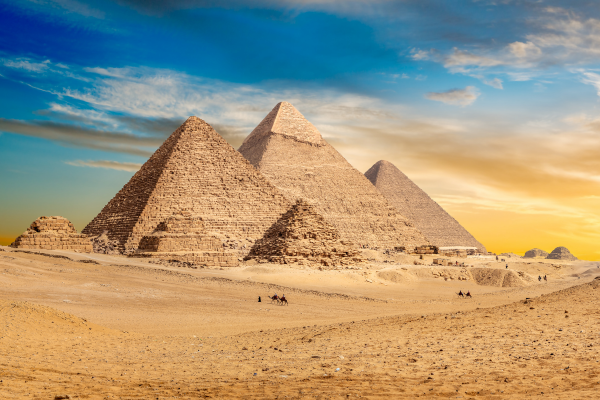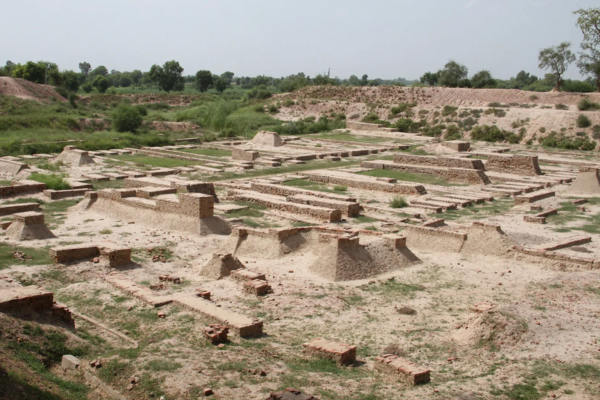.png)
Civil Engineering Wonders of the Ancient Era
Civil engineering, though perceived as a modern discipline, has roots that reach deep into the annals of human history. Ancient civilizations, with their towering edifices, complex city plans, and innovative construction techniques, laid the foundation for the engineering marvels we behold today. This blog delves into the engineering feats of three paramount ancient civilizations: Mesopotamia, Egypt, and the Indus Valley. From the majestic ziggurats of Mesopotamia and the iconic pyramids of Egypt to the meticulously planned cities of the Indus Valley, we journey through time, tracing the genius of our ancestors. Join us as we explore the confluence of art, science, and ambition that shaped the world's earliest engineering wonders.

Mesopotamia: Engineering Marvels from the Cradle of Civilization
Mesopotamia, often called the 'Cradle of Civilization,' was the birthplace of writing and urbanization and a beacon of architectural and engineering prowess. Situated between the Tigris and Euphrates rivers, this ancient civilization laid the groundwork for many practices and techniques we recognize in modern civil engineering. Dive into the engineering feats that defined Mesopotamia:
The Majestic Ziggurats
Among the most iconic structures of ancient Mesopotamia are the ziggurats. These terraced pyramid-like structures rose from the flat landscape, serving as religious sanctuaries and demonstrations of political power. Unlike the solid pyramids of Egypt, ziggurats were composed of a series of stepped platforms, often with a temple or shrine on top.
One of the most famous is the Ziggurat of Ur, which stood at a towering height in its day. Built using sun-dried bricks and baked bricks for the outer facades, these structures were engineered to last, with many of their remnants still surviving.
Irrigation and Agriculture
Mesopotamia's advancement wasn't restricted to towering edifices alone. The region's agrarian society thrived due to its innovative irrigation techniques. Engineers of the time constructed canals, reservoirs, and dams, turning arid landscapes into fertile fields. This understanding of controlling water flow laid the foundation for future hydraulic engineering practices.
The Wonders of the City of Babylon
Babylon, one of Mesopotamia's most famous cities, was home to the legendary Hanging Gardens, one of the Seven Wonders of the Ancient World. While there's still debate about the garden's existence and exact appearance, ancient accounts describe a series of terraces with a vast array of trees, shrubs, and vines, showcasing the time's innovative gardening and irrigation techniques. Furthermore, Babylon's city walls were marvels of ancient engineering, offering robust defense mechanisms and astoundingly vast scale.
Cuneiform and record-keeping
While not strictly an engineering feat, developing cuneiform, the world's first writing system, was pivotal in advancing engineering and architectural projects. Through cuneiform inscriptions, rulers, architects, and engineers could maintain records, draft plans, and ensure the smooth execution of construction projects.
Mesopotamia's achievements in engineering and architecture remain a testament to human ingenuity and the drive to create, innovate, and transform the environment. From the grandeur of ziggurats to the intricate canal systems that nourished the land, Mesopotamia's legacy is one of brilliance, resilience, and a quest for knowledge that continues to inspire civilizations thousands of years later.

Egypt: Engineering Wonders Along the Nile
The ancient Egyptian civilization, nestled along the banks of the Nile, is renowned for its breathtaking monuments, profound cultural advancements, and pioneering engineering feats. More than just pyramid builders, the Egyptians were master planners, architects, and engineers who left behind a legacy that has mesmerized the world for millennia. Here's an exploration of the engineering marvels of ancient Egypt:
The Iconic Pyramids
No mention of Egyptian engineering would be complete without the pyramids. These monumental tombs, built for pharaohs and nobles, are marvels of precision and innovation. The Great Pyramid of Giza, the largest of the three pyramids at Giza and one of the Seven Wonders of the Ancient World, was constructed using massive limestone blocks, each weighing an average of 2.5 tons.
The alignment of the Great Pyramid's sides with the cardinal points of the compass and its precise dimensions are testimony to the Egyptians' deep understanding of astronomy and geometry.
Temples and Obelisks
Apart from pyramids, Egyptian engineers built awe-inspiring temples dedicated to gods and goddesses. The Temple of Karnak and the Temple of Luxor are exemplary specimens of grandeur, architectural design, and engineering might.
The obelisks, tall, four-sided pillars tapering towards the top, further exemplify the Egyptians' ability to quarry, transport, and erect massive stone structures, often inscribed with hieroglyphics to honor deities or commemorate rulers.
Hydraulic Engineering: The Nile's Blessing
The Nile, the lifeblood of Egypt, was central to its prosperity. Egyptians developed advanced irrigation techniques, using the Nile's annual inundation to their advantage. They constructed canals, basins, and shadoofs (manual irrigation tools) to irrigate fields, ingeniously harnessing the river's ebb and flow.
Construction Techniques and Tools
The Egyptians utilized simple yet effective tools like rollers, sleds, and levers to move and position enormous stone blocks. They deeply understood materials, using mud-brick for routine constructions and reserving limestone and sandstone for monumental structures. Their use of copper tools, wooden cranes, and complex labor organizations played crucial roles in completing mammoth projects.
Planning and Administration
The organized layout of cities, granaries, and storage facilities revealed the Egyptians' planning capabilities. Efficient record-keeping, enabled by the invention of hieroglyphic writing on papyrus, facilitated the planning and execution of large-scale projects.
Ancient Egypt's engineering wonders are not mere relics of the past but resonant reminders of a civilization's brilliance, resilience, and ambition. From the shadow of the pyramids to the rhythmic flow of the Nile, Egypt's legacy stands as a testament to the boundless potential of human ingenuity and the timeless quest to reach for the stars while rooted in the earth.
Indus Valley Civilization: Ingenious Urban Planners of the Ancient World
The Indus Valley Civilization, spanning present-day Pakistan and northwest India, stands out as one of the ancient world's earliest and most sophisticated urban cultures. Flourishing around 2500 BCE, this civilization, while perhaps less monument-centric than its Egyptian or Mesopotamian counterparts, was unparalleled in its understanding of urban planning, sanitation, and civil engineering. Journey with us through the engineering feats of the Indus Valley:
Blueprints of Brilliance: Harappa and Mohenjo-Daro
Cities like Harappa and Mohenjo-Daro are prime examples of the Indus Valley's urban genius. These cities were characterized by a grid-like pattern, with wide, straight streets and standardized brick sizes — a level of uniformity that's astounding even today's standards.
Houses, often multi-storied, were built with baked or sun-dried bricks and had inner courtyards. These residential areas were well-equipped with amenities, showcasing a quality of life that was advanced for its time.
Masters of Water Management
One of the most significant achievements of the Indus Valley Civilization was its advanced drainage and sewage systems. Almost every house in Mohenjo-Daro had a private well and a bathroom. Wastewater from homes flowed into covered drains lined the main roads — a feat that underscores the civilization's priority on hygiene and sanitation.
Moreover, the Great Bath of Mohenjo-Daro, a large public water tank, indicates the societal importance of ritualistic cleansing and the engineering skill involved in its construction and waterproofing.
Standardization and Measurements
The civilization's penchant for standardization was wider than brick sizes. Archaeological finds have revealed standardized weights made from chert, suggesting a unified system of measurement and trade. This level of uniformity and standardization hints at a centralized authority or, at the very least, efficient communication and shared standards across the vast expanse of the civilization.
Protective Walls and Granaries
Cities of the Indus Valley were often fortified with massive walls, potentially serving dual purposes of flood defense and protection against invaders. The granaries, like the one in Harappa, with a series of air ducts, reflect a deep understanding of storage techniques, ensuring grains remain fresh and free from pests.
The Mystery of the Script
While not directly an engineering marvel, the Indus Valley's undeciphered script, often inscribed on seals, suggests a complex system of communication and record-keeping. Deciphering this script could unlock more secrets about this civilization's engineering and societal advancements.
The Indus Valley Civilization, though shrouded in many mysteries, offers profound insights into the urban and engineering capabilities of ancient societies. Their cities, with meticulously planned streets, advanced sewage systems, and standardized construction practices, are timeless testament to their ingenuity, foresight, and ability to harmonize with their environment. Their legacy resonates as a beacon of human innovation, echoing through the annals of history.
As we journey back to the era of ancient civilizations and tread the cobbled streets of Mesopotamia, gaze up at the towering pyramids of Egypt, and traverse the well-planned avenues of the Indus Valley, a profound realization dawns upon us. These magnificent structures and the sophisticated engineering techniques behind them were not merely constructs of stone, mud, or brick; they were manifestations of humanity's timeless spirit of innovation and ingenuity.
From Mesopotamia's ziggurats and its intricate irrigation systems to Egypt's awe-inspiring temples and its mastery over the Nile, and then to the Indus Valley's exemplary urban planning and undeciphered scripts, we see civilizations that, though separated by vast expanses of land and time, shared a common pursuit: to challenge the limits of what was possible. Armed with rudimentary tools yet profound knowledge, these pioneering societies laid the cornerstone for the marvels of civil engineering we witness today.
In conclusion, the legacies of these ancient civilizations serve not only as a testament to human potential but also as inspiration. They beckon today's engineers to blend creativity with science, innovate, and always reach for the stars while grounded in past lessons. For in the echoes of the past, we often find the blueprints for a brighter future.
Click to explore 👉 https://app.bidlight.com
